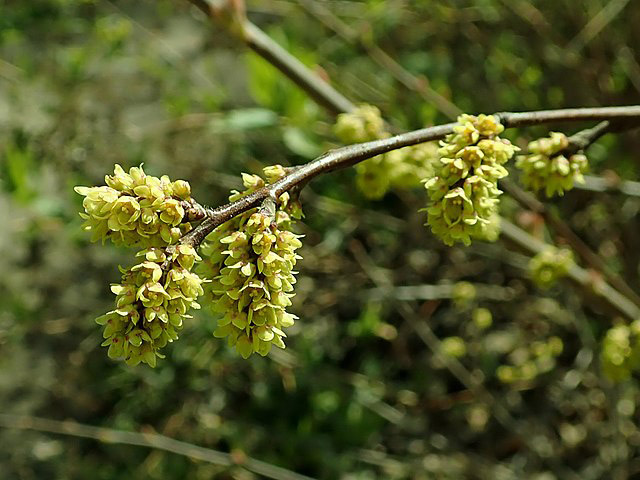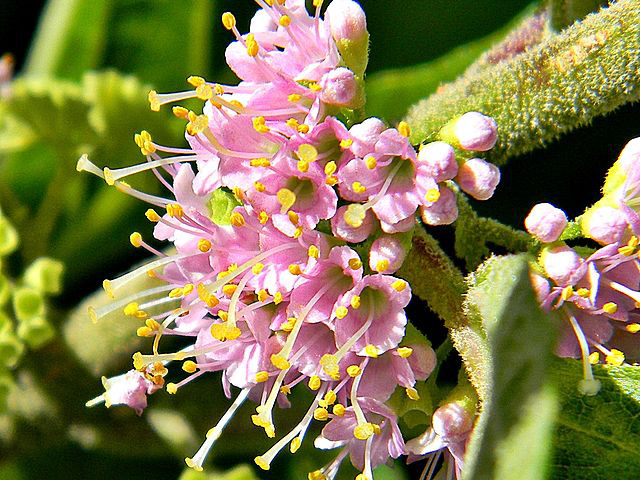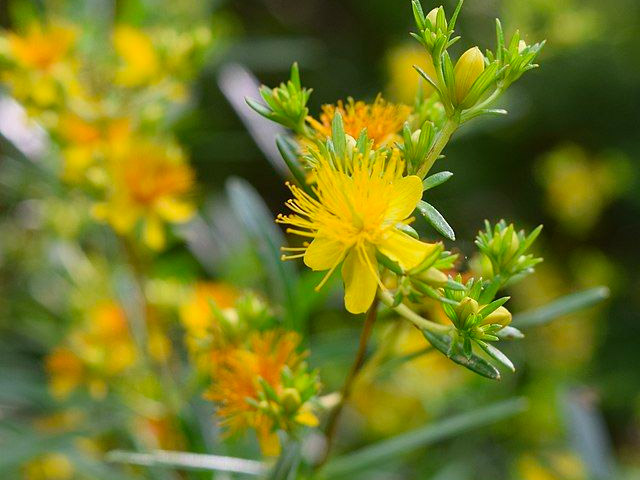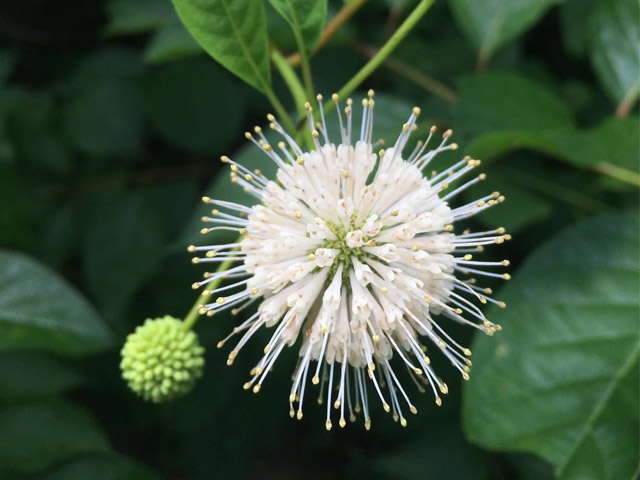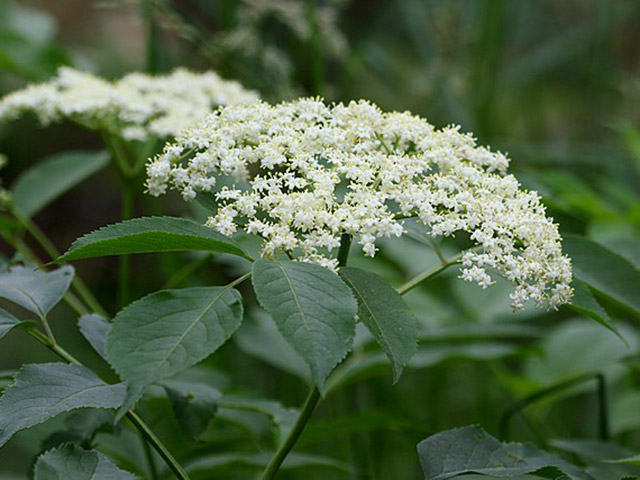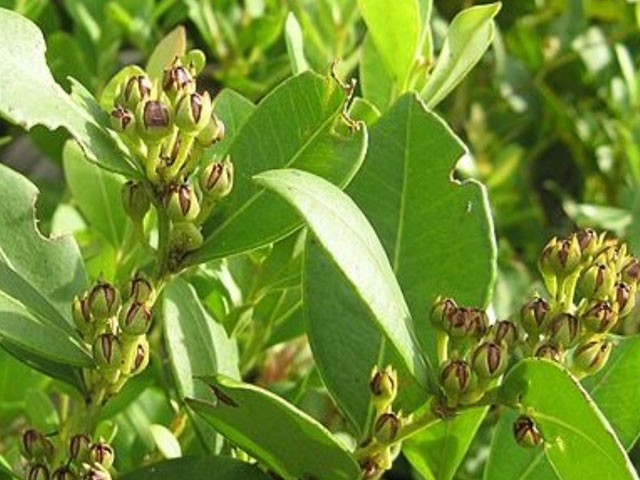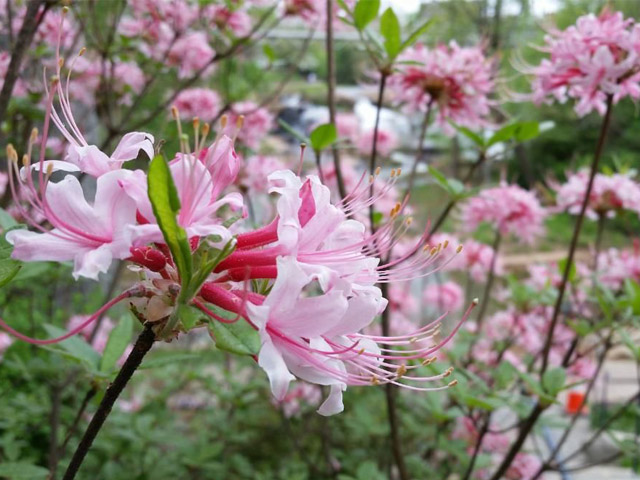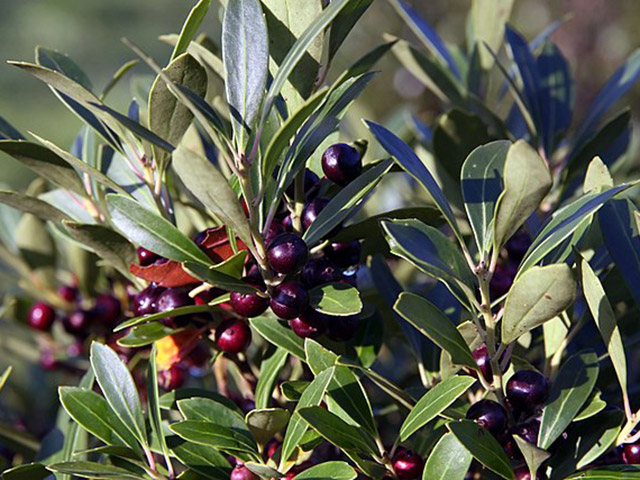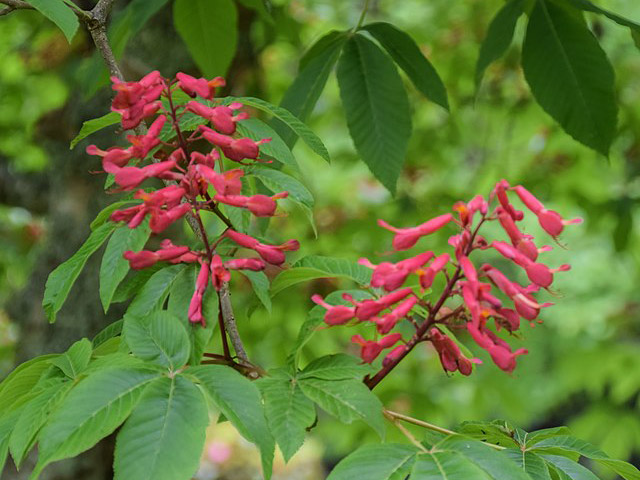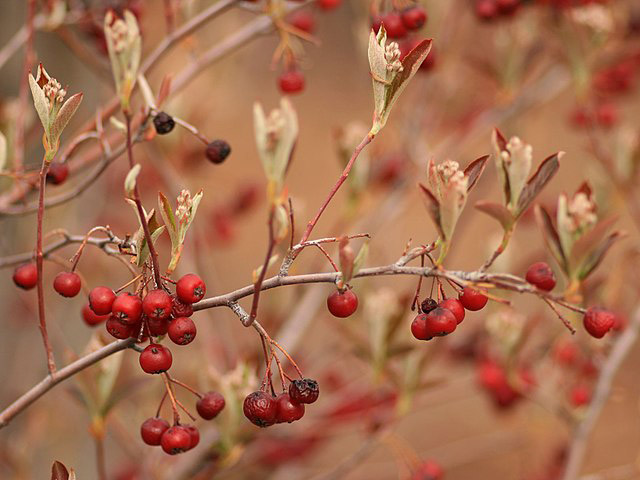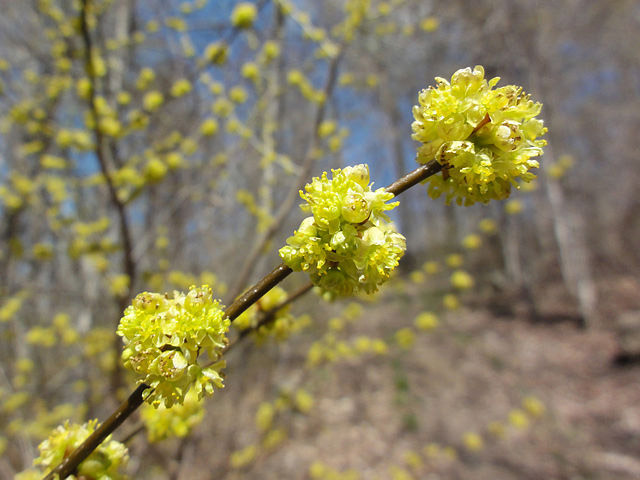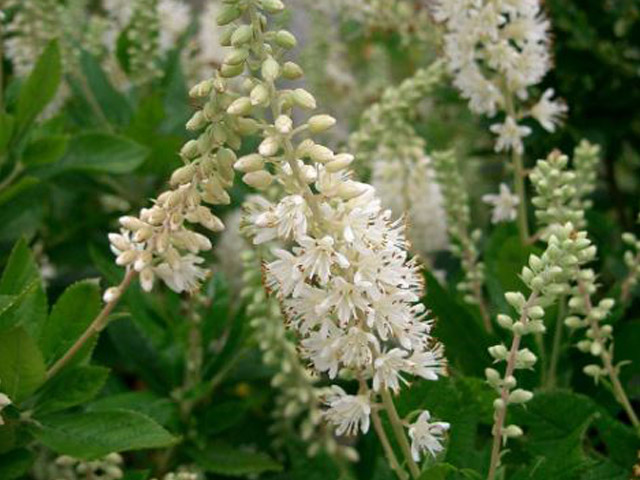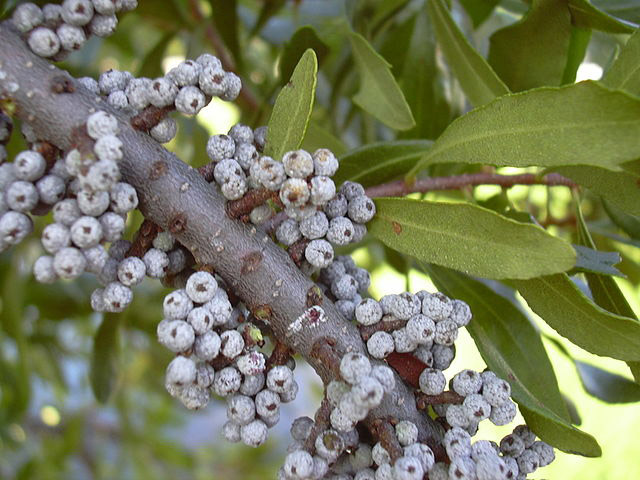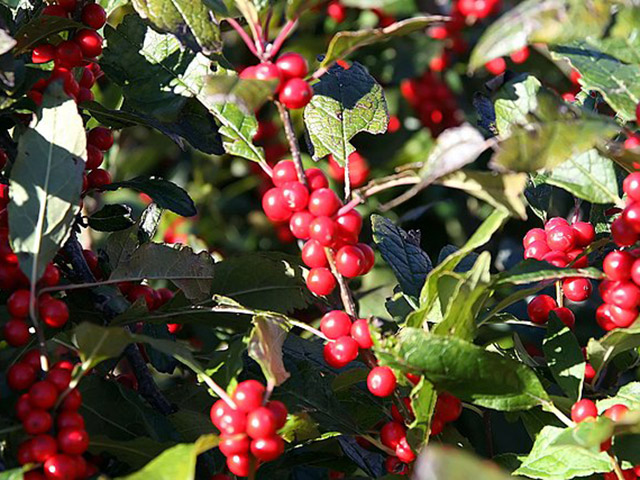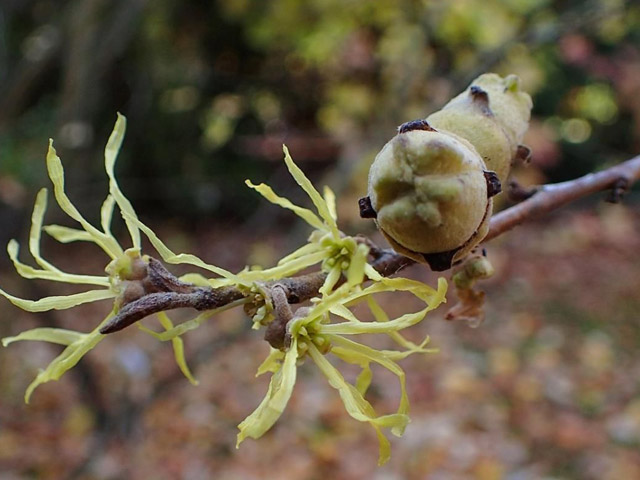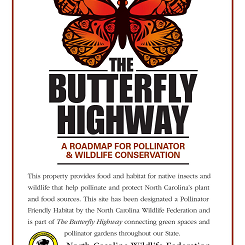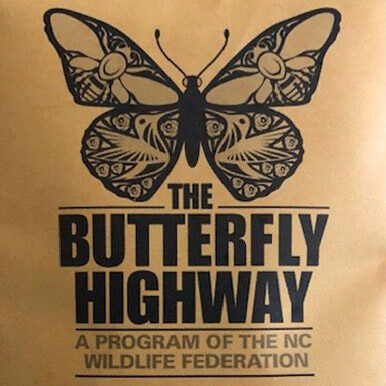Native Pollinator Shrubs
Recommended Shrubs
Shrubs provide excellent cover and places to raise young and there are a wide variety of evergreen options in North Carolina.
Below is a list of suggested shrubs native to North Carolina. Most of the shrubs listed can be found in all three major regions of North Carolina (Piedmont, coastal, mountain). This list isn’t intended to be comprehensive and only highlights a selection of native shrubs that many nurseries and garden centers are likely to carry.
North Carolina Native Shrubs
Aromatic Sumac
Aromatic sumac, Rhus aromatica, is a native, deciduous shrub that grows in central and eastern North America. It can be found naturally occurring in dry, rocky prairies, open fields or open woodland habitats.
Aromatic sumac is a suckering plant that typically forms colonies and grows to a height of 2-6 feet tall. This spreading habit, along with its tolerance for drought and erosion, makes it a perfect plant for sloping hillsides or other areas where erosion is a concern. Aromatic sumac prefers rocky, dry soils, but can adapt to a variety of well-draining soils that range from sandy-loam to clay. It can be planted in full sun or partial shade with medium moisture.
This shrub tends to bloom in late winter or early spring. The female produces a cluster of fragrant flowers that are yellowish-gold, while the male flowers form as catkins that droop from the stems. Bright red, hairy fruits develop by late summer after the female plants are pollinated.
The leaves of aromatic sumac are a glossy green that often turns a reddish-purple or golden color in fall. The leaves are trifoliate, meaning they have three parts to the leaf, and emit a strong fragrance when crushed. The leaves are also the larval host for luna moth and red-banded hairstreak caterpillars.
Aromatic sumac flowers attract adult butterflies and bees with their pollen and nectar. When the berries ripen, wildlife such as turkeys, ruffed grouse, robins, and flickers flock to the shrubbery, as well as small mammals like raccoons, possums, and chipmunks. Not only is this plant a great source of food for a variety of wildlife, but it also provides cover for small mammals and birds.
Aromatic sumac makes a great addition to sloping hillsides, but can also be incorporated into butterfly gardens, natural areas and sensory gardens.
Fun Fact: Aromatic sumac has allelopathic (growth-inhibiting) properties so make sure to plant in mass groupings or with plants that are compatible.
American Beautyberry
American beautyberry, Callicarpa americana, is a native, medium-sized shrub that is found in central and southeast North America. It can be found growing in open woodlands, meadows and thickets.
American beautyberry prefers full sun or partial shade and can grow between 3-8 feet high. It has an erect, arching habit which can be used to add height and texture to borders or garden beds. It prefers moist, well-draining soils but has a good tolerance for periods of drought. It can be grown in all three regions of North Carolina.
In the early summer, loose clusters of tiny flowers appear in the axils where the leaves meet the stem. Blooms may range from white to pink to purple. Once pollinated, these flowers will ripen into vibrant purple berries that whorl and cluster around the stem.
The berries ripen in early to late fall and are eaten by an abundance of wildlife including song birds, game birds, deer, raccoons, opossums and foxes. Around the same time, the shrub's bright green leaves turn a golden yellow before dropping off the plant, creating a beautiful contrast with any remaining berries.
American beautyberry can be added to a rain garden, winter garden, pollinator garden or a naturalized area.
Fun Fact: American beautyberry has been found to contain two compounds in its leaves and other parts of the plant that naturally repel mosquitoes.
Bushy St. John's Wort
Bushy St. John's wort, Hypericum densiflorum, is a deciduous shrub that is native to eastern and central regions North America.
It grows in a variety of settings including wetlands; wet meadows, woods or roadside ditches; and pond, lake and stream banks.
This small to medium sized shrub reaches a height of 2-7 feet tall with an erect and dense growth habit. It can be pruned in early spring to a desired size and shape. Bushy St. John's wort is commonly planted in shrub borders or as a foundation plant. It prefers full sun to partial shade and is adaptable to a variety of soil conditions.
From June to September, bright yellow flowers bloom in dense, flat cymes on the new growth of the shrub. Each flower consists of five petals and multiple stamens, giving them a frilly appearance. These attractive flowers are beautiful in the landscape and attract a variety of pollinators. In the fall, the flowers will develop into cone-shaped seed capsules which attract songbirds.
Bushy St. John's wort is an adaptable shrub that makes a great addition to slopes, riparian areas, and pond landscapes. It is can also be incorporated into a pollinator garden or rain garden.
Fun Fact: Bushy St. John's wort is commonly found in the coastal and mountainous regions of North Carolina, but is rarely found in the Piedmont.
Buttonbush
Buttonbush, Cephalanthus occidentalis, is a multi-stemmed shrub native to the Eastern U.S. that can be naturally found growing in swampy areas, along ponds or streams, and in prairie swales. Adaptable to several soil types, buttonbush can be found in all 3 regions of North Carolina. It can be planted in both full sun or in partial shade conditions and can reach a height of 5 to 8 feet tall. It has a long bloom time as it begins to bloom in June and continues until August.
The flowers of buttonbush are small but create a spherical cluster with protruding pistils from the tubular petals. They are usually white but can also be light pink or cream in color. The flowers are excellent for pollinators and will attract bees, butterflies, hummingbirds and other beneficial insects. According to research by Doug Tallamy, buttonbush supports 24 species of various moths and butterflies as their larval host plant. Not only does it support pollinators and caterpillars, but the bushy habit of the shrub also provides cover for small mammals and amphibians. The bushy habit, however, can be trimmed up in a garden setting for a neater appearance. Although the leaves do not have a very prominent fall color, the seed heads turn a vibrant red in early autumn and make a striking appearance in the garden. In the winter, the seeds of button bush are eaten by songbirds, ducks, as well as other waterfowl and shorebirds. Due to the buttonbush's tolerance of wet soils, it is an excellent plant for a bog garden, wetland garden, rain garden or as a planting around a pond area.
Fun Fact: Buttonbush was deemed one of the top most beneficial native plants by the USDA as it provides food for 24 species of insects, 8 waterfowl species, 3 mammalian species and several pollinators.
Carolina Allspice (Sweetshrub)
Carolina allspice, Calycanthus floridus, is a native shrub that is found in the southeastern region of the United States. It can be found naturally growing in woodlands, forests, and along stream banks and can be grown in all three regions on North Carolina.
Carolina allspice has an erect, rounded growth habit, often growing 6 to 12 feet tall. It is adaptable to both full sun and full shade conditions, but preforms best in dappled sun or partial shade. It likes moist, well draining soils and is tolerant of brief flooding or drought once established. After flowering, it can be pruned to maintain its shape.
In late spring, reddish-brown flowers develop on the ends of branchlets on old growth wood. The flowers attract pollinators, especially butterflies and beetles. Its broad, green leaves provide cover during the spring and summer for wildlife.
Add Carolina allspice to a native plant garden, shade garden, woodland garden, rain garden or naturalized area. It can also be incorporated into a hedge or border.
Fun Fact: The flowers produce a fruity fragrance.
Elderberry
Elderberry, Sambucus canadensis, is a woody and herbaceous shrub found in the eastern and mid-western regions of North America. It naturally grows in all regions of North Carolina in moist woodlands, edge habitat, meadows, stream banks and disturbed areas.
Elderberry is a medium-sized shrub that can reach 9 to 12 feet tall. It's arching, multi-branched stems give it a dense appearance that is perfect for hedgerows and borders. It can grow in wet to dry soil, but does best in moist, rich soils that are located in full sun to partial shade. Elderberry is a fast grower, but heavy pruning in the winter can help maintain your desired size and form.
Dense, flat-topped clusters of white flowers are borne on the terminal ends of its branches from May to July, attracting a diversity of pollinators. It has compound leaves with 4-6 pairs of leaflets and one terminal leaflet. The leaves turn from green to yellow at the onset of fall. Elderberry's pithy stems are often used by wood nesting bees who lay their eggs in these hollow stems.
Once pollinated, black or dark purple berries develop by late summer, attracting a variety of songbirds and other wildlife such as deer that browse the twigs and the leaves. The dense habit of the shrub also provides great cover for quail and other small wildlife.
Elderberry can be incorporated into a naturalized area but is also a charming addition to a rain garden, pond garden, pollinator garden or wildlife food plot.
Fun Fact: Cooked elderberries are commonly used to make pies, cakes, jellies, wine and other victuals.
Fetterbush
Fetterbush, Lyonia lucida, is an evergreen shrub native to the mid-Atlantic and southeastern regions of the United States and into Cuba. It is commonly found in bogs, swamps, and other moist habitats. This species is best grown on the coastal plain and eastern piedmont of North Carolina, however, Lyonia ligustrina may be a good substitute for the mountains and western piedmont regions.
Fetterbush has an arching habit, growing 3 to 6 feet tall with the tendency to spread via suckers to form dense colonies- perfect for a hedge or privacy screen. It is best planted in partial shade with moist, well-draining soils, but it is also quite adaptable to full shade or gardens with other soil moisture levels.
Pinks, bell-shaped flowers develop in clusters along its arching branches in the spring, attracting a variety of bees, butterflies and other pollinators. It's green, glossy leaves are alternately arranged along the stem and persist year-round. It's dense, evergreen qualities provide effective cover for songbirds, small mammals and other wildlife throughout the year.
Fetterbush can be pruned into a hedge or screen, but it can also be incorporated into a rain garden, pollinator garden, shade garden or naturalized area. Its leaves and flowers, however, are poisonous when ingested so be sure to plant in an appropriate location away from pets, animals or children.
Fun Fact: Fetterbush is a common plant in Okefenokee Swamp and other cypress or pineland wetland habitats.
Hoary Azalea
Hoary azalea, Rhododendron canscens, is a large deciduous shrub that is native to the southeastern region of North America. It is commonly found growing in swampy areas, along streams or in moist wooded landscapes.
Hoary azalea typically grows 6 to 8 feet tall in a variety of lighting conditions, from dappled shade to full sun. It likes moist, but well draining soils and grows in all three regions of North Carolina, making it an excellent addition to a garden for spring blooms.
These azaleas may begin blooming as early as March and some persist as late as May. The trumpet-shaped flowers grow in clusters of 5-9 flowers on the terminal ends of the branches. The flowers are pinkish-white with long protruding stamen and pistils. They emit a sweet fragrance that attracts butterflies, bees and hummingbirds alike. The green leaves turn bright red or burgundy in the fall before dropping to the ground.
Hoary azalea and other native azaleas add spring color to naturalized areas, woodland gardens, or pollinator gardens.
Fun Fact: While azaleas are beautiful, it is important to keep in mind that the leaves are toxic when ingested by humans and some other mammals, such as dogs, so make sure to plant it in appropriate areas.
Inkberry
Inkberry, Ilex glabra, is a small evergreen shrub that is native to sandy woods, swamps and bogs of the southeast, along with the coastal plains of the Northeast.
Inkberry can reach 5-10 feet tall and often forms colonies by suckering and spreading stolons. While it is a low maintenance plant, occasional pruning may be needed to maintain a desired shape.
It is best planted in full sun to partial shade, and can adapt to clay or sandy soils. Inkberry likes moist or occasionally wet soils and has the most success when planted in the Piedmont or Coastal Plain of North Carolina.
In early summer, inkberry produces greenish-white flowers that appear along the stems in cyme inflorescence clusters. A male and female plant must be in close proximity for cross-pollination to occur in order for the females to produce berries. The flowers are a great source of nectar and pollen for a variety of pollinators and they are commonly used in the production of gallberry honey.
Dark purple-black berries develop on the female plant and ripen in the fall. These berries will persist into the winter if they aren't first eaten. The evergreen leaves are arranged alternately on the stems and are dark green and glossy.
Inkberry provides a number of resources for wildlife. It is a host plant for the Henry's elfin butterfly, and the evergreen leaves provide great, year-round cover for birds and other wildlife. The leaves and berries are commonly eaten by deer and rabbits. Bobwhite quail, wild turkeys, songbirds and other wildlife feed on the berries, as well.
Inkberry bushes form nice hedgerows and privacy barriers with winter interest. They also serve well in wetland gardens, pollinator gardens or rain gardens.
Fun Fact: Tea was made from dried and roasted inkberry leaves by the indigenous peoples of North America.
Large Witch-Alder
Large witch-alder, Fothergilla latifolia, previously known as F. major, is a deciduous shrub native to the Southeast found on summits, slopes, stream banks, and in wet meadows throughout the mountains and Piedmont of North Carolina.
Large witch-alder is a medium-sized shrub that grows from 6-12 feet tall. It is multi-stemmed and rounded in its growth habit and commonly situated in full sun to partial shade. While this witch-alder prefers moist soil with good drainage, it can also tolerate extremes such as drought or saturated soil.
White, brush-like flowers appear on the terminal ends of the branches from April to May. These feathery, often fragrant, flowers attract a variety of bees and butterflies. The seed capsules and cover provided by the foliage attract songbirds. Deer are not attracted to large witch-alder. In the fall, its dark green leaves turn a fiery yellow-orange before dropping off the shrub.
Large witch-alder is an excellent addition to a rain garden, wetland garden, pollinator garden or native plant garden. Common cultivars of this native plant include 'Ark Beauty,' 'Blue Shadow,' and 'Mt. Airy'.
Fun Fact: Dwarf witch-alder, Fothergilla gardenii, is the witch-alder species that can be found on the coastal plain.
Red Buckeye
Red buckeye, Aesculus pavia, is a small to medium deciduous shrub that is native to eastern and central regions of North America. It can be found naturally occurring in hardwood forests, along stream banks and on sloping hillsides.
When adding red buckeye to your garden, be sure to plant it in an area that receives partial sunlight and has moist, well-draining soil for best results. As a medium-sized shrub, it typically matures to a height of 15-25 feet.
In spring, a red panicle inflorescence appears on the terminal ends of the shrub's branches. These tubular flowers attract a diversity of pollinators from hummingbirds to butterflies to bees that scour the flower clusters for nectar and pollen. After pollination, the flowers produce a capsule of 1 to 3 nutlets that are foraged by squirrels and other wildlife.
The palmate leaves resemble a spread-out hand, having five segments in a singular leaf. Red buckeye leaves will turn a brilliant yellow before dropping off the plant in late summer or early fall. Make sure to keep your red buckeye well watered during dry spells to prevent early leaf drop.
Red buckeye is an excellent addition to a woodland forest, naturalized area, pollinator garden or rain garden. It can also be incorporated into landscapes as a specimen tree. Due to its poisonous qualities, make sure to plant it out of reach of curious pets and children.
Fun Fact: Pioneers used the wood to make a black dye and incorporated the roots into soaps.
Red Chokeberry
Red chokeberry, Aronia arbutifolia, is a medium sized, multi-stemmed native shrub found in wet and dry thickets, swamps and bogs in eastern North America.
It is a deciduous shrub that typically grows in an erect, vase shape form. Red chokeberry grows 6-10 feet tall, 3-4 feet wide, and can sucker to form colonies. The shape and versatility of red chokeberry makes it great addition to a variety of naturalistic landscapes.
Red chokeberry's versatility includes adaptability to differential light and soil conditions. It can also be grown in full sun or full shade, however, more berries will be produced when the plant is exposed to longer periods of sunlight. While it prefers medium soil moisture, it will also tolerate wet or dry soils.
In the spring, -petaled, white flowers form in loose clusters that hang from the branches. Each flower has pinkish-red anthers that protrude from the center. These flower clusters attract a variety of pollinators from bees to butterflies who come to collect pollen or drink nectar. The leaves are a bright green in the summer and turn an orange-red in the fall.
After pollination, red berries can develop and persist on the shrub from fall to early winter. Due to the astringent taste of the berries, many songbirds opt for other native fruits and seeds. The berries are more commonly eaten by game birds, deer and bear, among other wildlife.
Between its adaptability and its wildlife value, red chokeberry would be a great addition to a native plant garden, winter interest garden or rain garden.
Fun Fact: It is a great native replacement for burning bush which is a commonly planted, but invasive, landscape plant.
Spicebush
Spicebush, Lindera benzoin, is a medium to large deciduous shrub that is native to the central and eastern regions of North America. It can be found naturally growing in moist or dry forests, slopes and swamps, or along stream banks.
Spicebush is a great garden addition for pollinator habitats in North Carolina. Not only does it grow in all three regions of the state, but it is also adaptable to several soil types and moisture levels. It typically grows between 8 and 15 feet tall and prefers to be planted in partial shade. Tolerant of both occasional flooding and droughts, spicebush is a reliable garden shrub.
As early as March, tiny greenish-yellow flowers emerge in clusters along the branches. They supply nectar and pollen for early emerging pollinators, and will attract both butterflies and bees. To produce berries, a male and female plant must be located near each other. Bright red drupes with a spicy scent develop on the female plants in late summer and early fall.
The light green leaves host both Palamedes and spicebush swallowtail butterflies. The leaves are fragrant when crushed and turn bright yellow in the fall before dropping off the plant. The red fruits are eaten by songbirds and deer will browse the twigs and leaves.
Spicebush is a champion pollinator plant that can be added to a butterfly gardens, winter gardens and rain gardens, or incorporated into hedgerows.
Fun Fact: Native Americans made tea from the leaves and dried berries for spices.
Sweet Pepperbush
Sweet pepperbush, Clethra alnifolia, is a woody shrub that is native to the southeast and is found naturally on coastal plains, pine lands, swamps, stream banks, and sea shores.
This deciduous shrub blooms in the late summer, producing 3 to 8 inch spikes made up of clusters of fragrant flowers. The sweet fragrance, along with the flowers being an excellent pollen and nectar source, attracts bees, butterflies and hummingbirds. The flowers are typically white and once pollinated, will form brown capsules that persist into the winter. The fruit is eaten by birds and mammals in the fall and winter as well. In the fall, the leaves turn a dull yellow or orange color giving this plant year-round seasonal interest.
Sweet pepperbush typically grows 3 to 6 feet tall but can get up to 12 feet tall. Luckily, this shrub responds very well to pruning. Pruning can be used to control the suckers that pop up or to keep the shape neat and tidy. It blooms on new growth, so pruning should be done in the winter so that it will still flower in the summer the following year. There are hardly any diseases or pest issues that affect sweet pepperbush and it can also grow in full sun or full shade making it every gardener's dream plant! It must be planted in moist or wet soils to preform its best, but it is versatile to sandy or clay soils. While it is not tolerant of drought conditions, it is tolerant of salt spray making it an excellent choice for gardens near the ocean.
In order to propagate sweet pepperbush, methods such as seed germination, division or softwood cuttings can be used. Sweet pepperbush is an excellent garden plant that can be used in hedgerows, foundation plantings, naturalized areas or rain gardens.
Fun Fact: Sweet pepperbush is often found in the understory of forests dominated by cypress, pine, beech and magnolia trees.
Swamp Rose
Swamp rose, Rosa palustris, is an upright, deciduous shrub that displays rose-pink flowers in late spring and into early summer. The stems of this rosy shrub typically have a red-burgundy color and are covered in prickles, just like most other roses. This native shrub can be found naturally growing in swampy thickets or along the banks of streams, lakes, and rivers. In a garden setting, the Swamp Rose requires moist to wet soils and needs to be planted in full sun to part shade. While it can grow in a shady area, it is best to plant it in full sun to encourage more flowering and to decrease susceptibility to fungal diseases which can often affect the rose family.
The Swamp Rose is a great addition to a rain garden or to a native pollinator garden. It's rose-pink flowers provides nectar and pollen for pollinators and is often used for nesting material or as a nesting site for natives bees. In the fall, the deciduous leaves of the Swamp rose will turn a nice red color and small red fruits will develop from pollinated flowers. The red fruits will attract songbirds, squirrels, quail and wild turkey in the fall and winter.
Fun Fact: The fruit of roses are known as 'hips' and are packed with nutrients that are beneficial to wildlife.
Wax Myrtle
The wax myrtle, Morella cerifera, is a large, evergreen shrub that is native to eastern North America, commonly found in swamps, marshes and along stream banks.
This shrub prefers full sun to partial shade and can grow in a variety of soil conditions. While they flourish best in moist or wet soils, wax myrtles are tolerant of both flooding and drought once established.
If you live on the coast or in areas where the roads are heavily salted, wax myrtles might be a great selection for your garden since they are highly tolerant to brackish water, salt and other tough conditions.
When it comes to wildlife services, wax myrtle can provide it all. Its evergreen leaves not only provide cover year-round, but it is also the larval host plant for the red-banded hairstreak butterfly.
In spring, small green flowers bloom along the old-growth branches that attract a variety of pollinators. However, in order for the flowers to ripen into berries, a male and female wax myrtle must both be present in the area. Once pollinated, the female plants produce grey-blue berries which ripen in the late fall and early winter. Birds and other wildlife, especially the yellow-rumped warbler, will hop between branches and forage the berries while they last.
Reaching a height of 6-12 ft. tall, this evergreen shrub is commonly planted as a screen plant in residential landscapes. It is also frequently used in habitat restoration projects, wetland gardens, hedgerows and other landscape designs.
Fun Fact: Wax myrtle berries were traditionally boiled to separate the berry from the waxy coating to glean wax that was used to make candles.
Winterberry
Winterberry, Ilex verticillata, is a native, deciduous shrub that is found near swamps, streams, river banks, ponds and lakes. Its preference for moist to wet soils allow it to thrive in habitats that are near bodies of water.
It is very adaptable to a variety of light conditions, with some growing in full shade and others growing in full sun. It is typically grown as a multi-branched large shrub, reaching a height of 10-15 feet tall, or as a small shrub with dwarf cultivars reaching 4-5 feet tall.
Winterberry offers a variety of wildlife benefits. Small, white flowers bloom along the stems in spring and early summer. The flowers grow close to the stem in clusters, attracting a variety of pollinators. In the fall, the pollinated flowers ripen into a tight cluster of bright red berries. In order for berries to develop, a male and female winterberry must be present in the same area so cross-pollination can occur. The berries only grow on the female shrub.
The leaves of winterberry are green during summer and may have caterpillars of the Henry's elfin butterfly munching on them. The leaves offer food to browsing deer and rabbits before turning yellow and dropping off in the fall. The berries ripen from August to December and provide food for 48 different bird species. These bright red berries offer beautiful winter interest in your garden as they persist on bare branches into late winter.
Winterberry is well-suited to many garden styles due to its high wildlife value and tolerance of wet soils, salt, and deer browsing. It is a great addition to hedgerows, rain gardens, native plant gardens, winter gardens and pollinator gardens.
Fun Fact: The specific epithet, verticillata, is a Greek word that refers to the whorled appearance that the berries have along the stem.
Witch Hazel
Witch hazel, Hamamelis virginiana, is a large, deciduous shrub that is native to the eastern half of North America. It can be found naturally growing in moist woodlands and thickets in full sun or partial shade.
Since it is a large shrub and may grow up to 15-20 feet tall, plant it in an area where it can either grow to that height or where it can be pruned easily. Witch hazel should also be planted in areas with good drainage and moist soil. While it cannot tolerate periods of drought, it will tolerate brief periods of flooding.
The leaves of witch hazel are bright green with wavy leaf margins that turn a gorgeous gold or copper color in the fall. Unique flowers appear along its stems in late fall or early winter, sometimes after the leaves have already dropped. The flowers are typically yellow or tan with spindly petals that emit a sweet fragrance.
As one of North Carolina's latest bloomers, witch hazel has a lot to offer wildlife. It provides nectar and pollen to late-flying pollinators when few floral resources are available, and the multi-branched shrub also offers great cover for wildlife. While it will attract some bees, witch hazel is mainly pollinated by noctuid moths. Once ripe, the fruits and seeds may be eaten by a variety of wildlife including wild turkey, songbirds, and small mammals.
Witch hazel can be a magnet for wildlife and makes a great addition to riparian areas, winter gardens, native gardens or woodland areas.
Fun Fact: Witch hazel has medicinal properties and is commonly used to treat inflammation and skin irritation.
Yaupon Holly
Yaupon holly, Ilex vomitoria, is an evergreen shrub or small tree that is native to the southeastern Atlantic region of North America. It can be found growing in maritime woods, sandy pinelands and other well-draining habitats in North Carolina.
Yaupon holly produces more fruit when planted in full sun, but it can also be planted in partial to full shade. It is an erect and multi-stemmed shrub that typically grows 10-20 feet tall, although it is a very slow growing plant. It adjusts well to pruning, allowing easy control over its shape and size for your garden needs.
This holly prefers well-draining soils, but is known to withstand periods of both drought and flooding. In addition to its tolerance for varying soil moisture levels, it is also a hardy plant that can withstand deer browsing or to salt-prone garden conditions.
In the spring, small greenish-white flowers develop on both the male and female plants. Although inconspicuous, pollinators such as bees and butterflies flock to the flowers in spring to gather pollen or sip nectar. The larvae of the Henry elfin butterfly may also be seen munching on the glossy, green leaves. Once cross-pollinated, the flowers ripen into bright red berries that persist on the shrub through the winter.
Several birds species, including robins and mockingbirds, eat the fruits in late winter and may use the branches as nesting sites. Some mammals, such as raccoons, foxes and skunks are also known to eat the berries.
Yaupon holly is a great addition to a rain garden, winter garden or pollinator garden. It can be incorporated into a hedgerow or privacy screening, while also providing habitat for wildlife.
Fun Fact: Yaupon holly was used by Native Americans to make caffeinated tea and a cleansing medicine.
Order Your Butterfly Highway Sign
Put up a Butterfly Highway sign to show off your amazing pollinator pitstop and start the conversation in your community about helping pollinators and conserving wildlife habitat.
Get Your Native Seed Packets
One packet of native seeds provides as many as 7 different kinds of native flowering plants for monarchs and other pollinators, creating up to 25 square feet of habitat. The seed variety includes purple coneflowers, milkweed, black-eyed Susans, and more!

